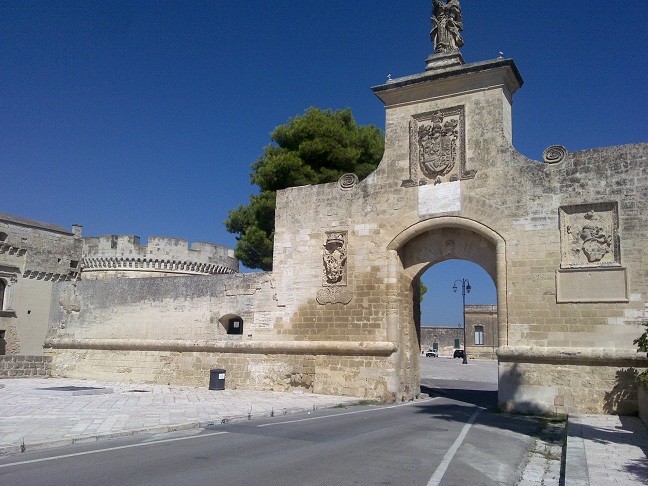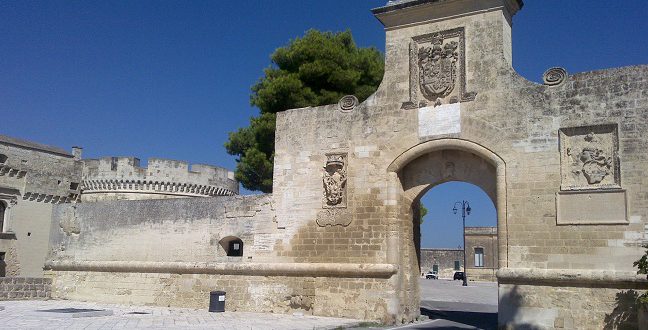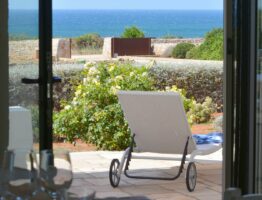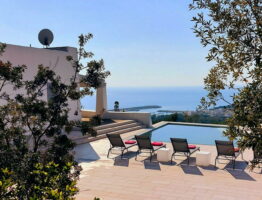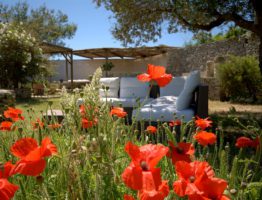Il borgo di Acaya, situato nell’entroterra, è di grande importanza nel panorama salentino in quanto costituisce il solo esempio di città fortificata del Meridione, a suo tempo interamente circondata da un fossato e da mura con feritoie di osservazione e difesa.
La cosa più interessante era la sistemazione urbanistica, a dir poco avveniristica per il periodo. Era stata infatti ideata e realizzata con un sistema viario rigorosamente geometrico: sette strade dritte da Nord a Sud si intersecavano con altre tre da Ovest ad Est. Punto estremo verso Sud era il Castello. Alla città si accede da un’unica porta meridionale sormontata dallo stemma dei re spagnoli e delle famiglie nobili che la abitarono: sul lato destro quello degli Acaya, al centro della chiave dell’arco lo stemma dei De’ Monti, baroni di Corigliano, ed a sinistra quello dei Vernazza, conti di Castrì, che nel 1792 eressero la statua di S. Oronzo, patrono della città. Nel 2001, durante il corso di scavi a pochi metri dalle mura, in prossimità delle scuderie, sono state riportate alla luce diverse tombe, fosse comuni e cunicoli contenenti ossa umane che appartennero probabilmente a uomini di età compresa tra i 25 e 30 anni. Probabilmente si trattava di soldati periti in una delle cruente battaglie che fra il 1200 ed 1300 tormentarono la zona, quando Acaya si chiamava ancora Segine.
Per la sua eleganza architettonica Acaya è stato scelta nel 2008 come sede del Forum Mediterraneo per la Pace. Dal 12 luglio al 31 ottobre del 2008 è stata allestita nel castello una mostra di architettura contemporanea del famoso architetto portoghese Alvaro Siza.
Ancora oggi Acaya sembra sospesa in una dimensione temporale unica: meta ideale per una passeggiata fuori dai centri turisti e balneari, è raggiungibile da Lecce in poco tempo. Inoltre l’ampia campagna circostante, ricca di uliveti, sembra costituirne l’involucro protettivo dagli eccessi e dal frastuono del vivere quotidiano.
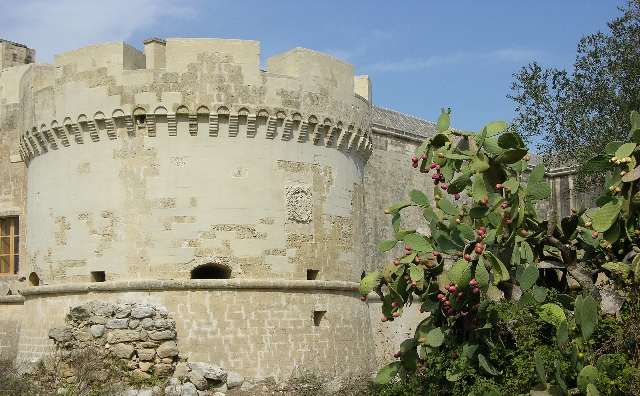
The village of Acaya, located inland, is of great importance in the Salento because it is the only example of a fortified city of the South, which had been fully surrounded by a moat and a wall with slits for observation and defense. The most interesting thing was the development project, futuristic for the period. It was in fact designed and built with a road system rigorously geometric: seven straight roads from North to South intersected with the other three from West to East. Point Far to the south was the Castle. The city is accessed from a single southern gate surmounted by the coat of arms of the Spanish kings and noble families that lived in: on the right side of the Acaya at the center of the keystone of the coat of arms of the De ‘Monti, the barons of Corigliano, and to the left of Vernazza, counts Castrì, which in 1792 erected a statue of St. Fred, saint patron of the city. In 2001, during the course of excavations at a few meters from the walls, near the stables, have been brought to light several tombs, graves and tunnels containing human bones, which probably belonged to men aged between 25 and 30 years. Probably were soldiers perished in one of the bloodiest battles between 1200 and 1300 that plagued the area when Acaya village was still called Segine. For its architectural elegance Acaya was chosen in 2008 as the seat of the Mediterranean Forum for Peace. From 12 July to 31 October 2008 has been set up in the castle an exhibition of contemporary architecture by the famous Portuguese architect Alvaro Siza.
Even today Acaya seems suspended in a unique dimension: ideal for a walk out from the centers and tourist resorts, can be reached by Lecce in a short time. In addition, the wide surrounding countryside, full of olive groves, seems constituting the protective covering from the excesses and bustle of everyday life.
Visita il nostro sito www.salentodolcevita.com e scopri tutte le soluzioni per crare la tua vacanza perfetta in Salento!
Visit our web site www.salentodolcevita.com and see all solutions usefull to create a perfect holiday in Salento!
